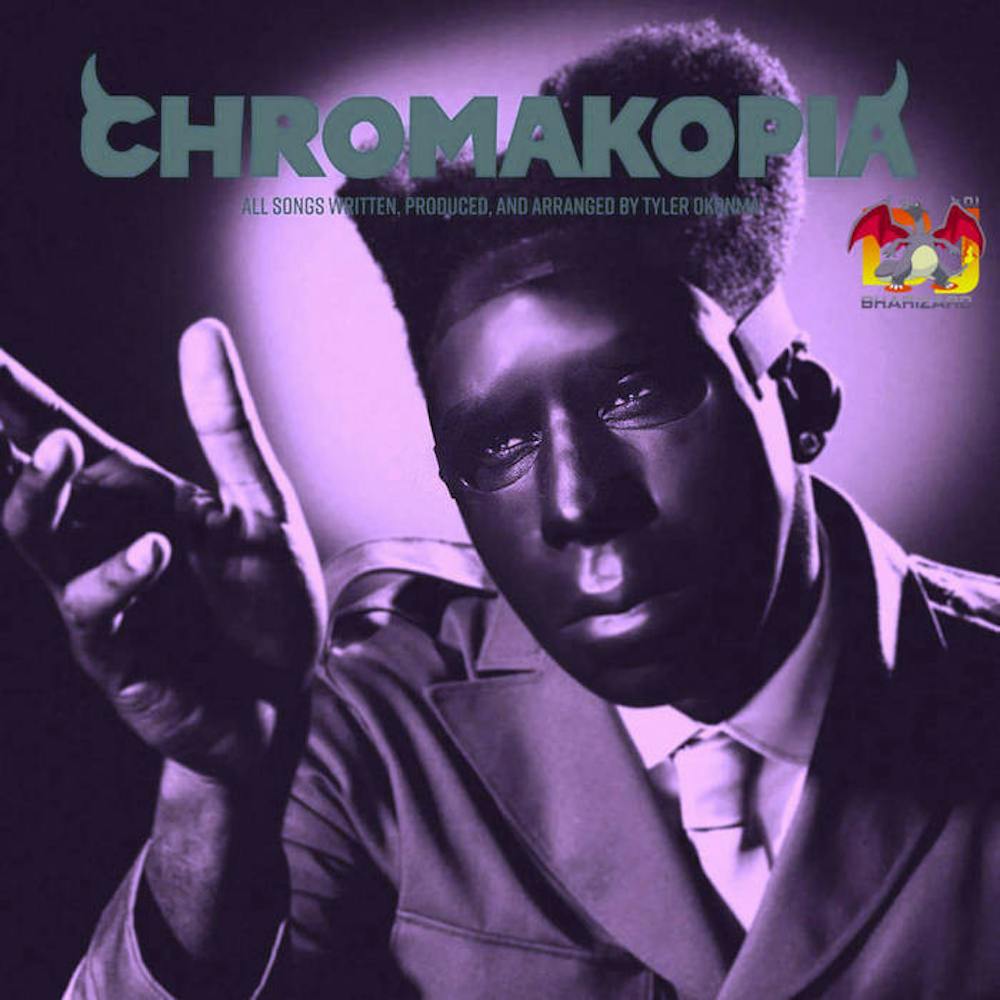‘Chromakopia’ bares all

Score: ★★★★
Key Track: “St. Chroma”
There are few artists that have had as eclectic of a transformation as Tyler, the Creator. Breaking into the game as a teenager in the irreverent rap collective Odd Future, Tyler Okonma has reinvented himself on pretty much every project he’s released since then — and this newest project is no exception. “Chromakopia” throws the quirky and manic edge of “Cherry Bomb,” the funky, psychedelic and soulful production of “Igor” and the introspection of “Flower Boy” into a blender to create a project that sees Okonma delve deeper into themes of family, queerness and identity than we’ve ever seen before.
Similar to Kendrick Lamar’s 2022 project “Mr. Morale & the Big Steppers,” the album investigates family trauma and how that has affected the artists today. Both albums feature a chorus of voices and a female narrator in their opening tracks. “St. Chroma,” the opening song of Okonma’s album, is introduced by his mother Bonita Smith, who says “You are the light/It’s not on you, it’s in you/Don’t you ever in your motherfucking life dim your light for nobody.”
Okonma was raised by a single mother, and he has long attributed his success to his mother’s motivation. The lines “Can you feel that light inside/Can you feel that fire?” are repeated throughout the song by R&B star Daniel Caesar. The “light,” the same “light” that his mom says to never “dim,” likely refers to a uniqueness that is completely and totally Okonma’s. With that interpretation, this opening song functions as a perfect introduction to the rest of the album, as Okonma peels back layers of himself, excavating his childhood and relationships and pulling off the metaphorical mask that graces the album’s cover.
While this album is Okonma’s most introspective since “Flower Boy,” it’s not warm and mellow like many of the tracks on that project were. This project is his most anxious and manic since “Cherry Bomb” and the album’s next two tracks “Rah Tah Tah” and “Noid” exemplify that. Okonma brings the noise on “Rah Tah Tah,” an industrial and trap-influenced banger that might break the Richter scale at concerts. It’s a brash, punchy track that seems almost chaotic, with heavy, distorted bass and frenetic drum patterns underscoring Okonma’s verses. “Noid,” like the title suggests, sees a paranoid Okonma unraveling over themes of distrust and pressure, layered over a jarring, dissonant beat that mirrors his internal turmoil. Here, Okonma’s voice is almost claustrophobic, switching rapidly between more restrained and incredibly frantic flows, as if he’s on the brink of something, exposing a restlessness that feels raw.
“Darling, I” sees Okonma dive back into the blend of R&B, soul and hip-hop prominent on both “Flower Boy” and “Igor.” On this track, Okonma melodically ruminates on love and commitment, with Teezo Touchdown providing gentle backing vocals. The synth funk influences on the track are very reminiscent of the groovy production that backed Okonma’s lyricism on “Igor”. The next song “Hey Jane” furthers these themes of love and commitment, but is even more vulnerable. The song feels similar to Kendrick Lamar’s “We Cry Together” off “Mr. Morale & the Big Steppers” in that it also features a conversation between a man and a woman. However, while Lamar raps the man’s part and “Zola” actress Taylour Paige takes the woman’s part on “We Cry Together,” Okonma raps both perspectives on “Hey Jane.” With lines that cut to the bone, “Hey Jane” feels like a moment where Okonma sheds the last of his armor, letting his guard down completely for a few soul-baring minutes.
The middle of the album features the project’s biggest duds: “Judge Judy” and “Sticky.” These songs, while not outright skips, lack the complexity and depth of the rest of the album. “Judge Judy” relies too heavily on its hook, feeling almost repetitive, while “Sticky” doesn’t quite mesh with the project’s overall mood, its playful beat feeling out of place among the more intense themes elsewhere on the album. They are bumps in an otherwise captivating journey, tracks that don’t necessarily take away from the whole but don’t add to it either.
The album, however, reaches new heights again with “Thought I Was Dead.” This track is electric, pulsing with life and energy as Okonma explores the push and pull between fame and authenticity. It’s an anthem for self-reclamation, as Okonma unapologetically claims space for himself, refusing to be pigeonholed or reduced. A couple songs later is “Like Him,” a soulful, powerful track that draws on gospel influences, with choir-like backing vocals that make it feel almost reverent. Okonma uses this moment to reflect on the struggles of accepting his own identity, unapologetically celebrating both the beauty and the pain of self-acceptance.
“Chromakopia” may not be Okonma’s most accessible album, but it’s certainly one of his most honest. With each project, he continues to push boundaries, redefining what it means to be both an artist and a man who, in his mother’s words, won’t “dim [his] light for nobody.”
More from The Rice Thresher

Andrew Thomas Huang puts visuals and identity to song
Houston is welcoming the Grammy-nominated figure behind the music videos of Björk and FKA twigs on June 27.

Live it up this summer with these Houston shows
Staying in Houston this summer and wondering how to make the most of your time? Fortunately, you're in luck, there's no shortage of amazing shows and performances happening around the city. From live music to ballet and everything in between, here are some events coming up this month and next!

Review: 'Adults' couldn’t have matured better
Sitcoms are back, and they’re actually funny. FX’s “Adults” is an original comedy following a friend group navigating New York and what it means to be an “actual adult.” From ever-mounting medical bills to chaotic dinner parties, the group attempts to tackle this new stage of life together, only to be met with varying levels of success.

Please note All comments are eligible for publication by The Rice Thresher.